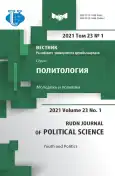Youth as an Object of Online Extremist Propaganda: The Case of the IS
- Authors: Abalian A.I.1, Bijan A.1
-
Affiliations:
- Saint Petersburg State University
- Issue: Vol 23, No 1 (2021): Youth and Politics
- Pages: 78-96
- Section: YOUTH IN POLITICS
- URL: https://journal-vniispk.ru/2313-1438/article/view/322132
- DOI: https://doi.org/10.22363/2313-1438-2021-23-1-78-96
- ID: 322132
Cite item
Full Text
Abstract
A youth audience is the most vulnerable part of society as an object of influence of radical ideas. The authors argue that the most efficient tool of involving young people of different origin and confessional affiliation into the extremist activity on the present stage is social networks. Despite the fact that the practice of using communication networks in the Internet space by terrorist organizations have existed before, it was the information policy of the ISIS (and later IS) that was characterized by the greatest effectiveness, due to the creation of an integrated media structure, which consisted of numerous foundations and agencies (“Al Furqan”, “Aynad”, “Itisaam”, “Al-Hayat”, etc.), allowing them to spread their extremist religious and ideological doctrine on a global scale. The use of the widest range of high-quality media products in Internet media and social networks has expanded the organization’s area of influence by attracting supporters not only from the Middle East region, but also from European countries and the Russian Federation. The case-study of the mechanisms for attracting European youth through social networks, such as Twitter, Facebook, etc., to extremist activities under the auspices of the IS is held. In conclusion, the prospects for the influence of IS propaganda in social networks after the defeat of a terrorist organization in 2018 are assessed. As a methodological basis of the research, aspect and activity approaches, as well as analytical, statistical methods and the method of content analysis are used.
Keywords
About the authors
Anna Igorevna Abalian
Saint Petersburg State University
Author for correspondence.
Email: a.abalyan@spbu.ru
PhD in Political Science, Assistant Professor, Department of Political Science
Saint Petersburg, RussiaAref Bijan
Saint Petersburg State University
Email: st082323@student.spbu.ru
Postgraduate Student in Political Science and Area Studies, Department of Political Studies
Saint Petersburg, RussiaReferences
- Awan, I. (2017). Cyber-Extremism: ISIS and the power of social media. Society, 54(2), 138-149. doi: 10.1007/s12115-017-0114-0
- Badawy, A., & Ferrara, E. (2018). The rise of jihadist propaganda on social networks. Journal of Computational Social Science, 1(8), 453-470. doi: 10.1007/s42001-018-0015-z
- Berger, J. M., & Morgan, J. (2015). The ISIS Twitter census: Defining and describing the population of ISIS supporters on Twitter. The Brookings Project on US Relations with the Islamic World, 3(20).
- Bernays, E. (2010) Propaganda. Hippo-Publishing, Moscow. (In Russian).
- Bodine-Baron, E., Helmus, T. C., Magnuson, M., & Winkelman, Z. (2016). Examining ISIS Support and Opposition Networks on Twitter. RAND Corporation.
- Cohen, A. R. (2012). In Internet’s way: Radical, terrorist islamists on the free highway. International Journal of Cyber Warfare and Terrorism, 2(3), 39-58.
- El Ghamari, M. (2017). Pro-Daesh jihadist propaganda. A study of social media and video games. Security and Defense Quarterly, 14(1), 69-90. doi: 10.5604/01.3001.0010.8472
- Kolesnikova, G. I. (2014). The Social Mechanism for Manipulating the Consciousness of the Individual. Direct-Media, Moscow. ISBN 978-5-4458-8089-9. (In Russian).
- Movchan, A. V. (2017). Prevention and counteraction to the propaganda of extremism among young people in Internet. Right. Economy. Security, 3(11), 72-73. (In Russian).
- Stern, J., & Berger, J. M. (2015). SIS: The State of Terror. Harpercollins. NewYork.
- Strebkov, A. I. Aleinikov, A. V., & Sunami, A. N. (2015). Russian youth extremism: Problems of understanding and counteraction. Criminology Journal of Baikal National University of Economics and Law, 9(4), 796-806. (In Russian)
- Volodenkov, S. (2016). Features and applications of Internet propaganda technologies in the political management. PolitBook, 4, 15-30. (In Russian)
- Winter, C., & Ingram, H. (2018). Terror, Online and Off. Recent Trends in Islamic State Propaganda Operations. Texas National Security Network. University of Texas
- Winter, C. (2015). The Virtual ‘Caliphate’: Understanding Islamic State’s Propaganda Strategy. London: Quilliam Foundation
- Yevdokimov, V. A. (2012). Propaganda in Internet. Polis. Political Studies, 4, 137-142. (In Russian)
Supplementary files









